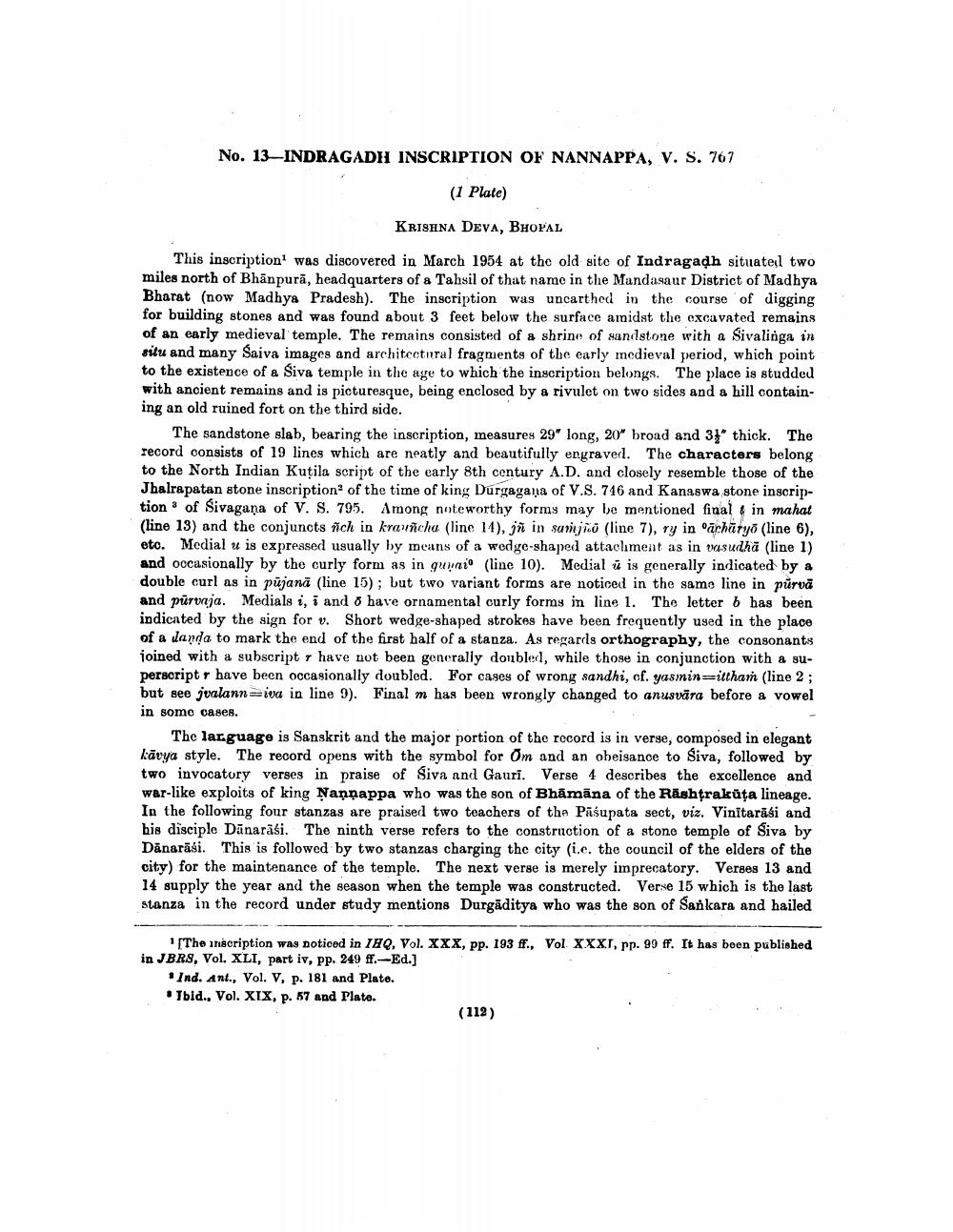________________
No. 13-INDRAGADH INSCRIPTION OF NANNAPPA, V. S. 767
(1 Plate)
KRISHNA DEVA, BHOPAL
This inscription was discovered in March 1954 at the old site of Indragadh situated two miles north of Bhanpurā, headquarters of a Tahsil of that name in the Mandasaur District of Madhya Bharat (now Madhya Pradesh). The inscription was uncarthed in the course of digging for building stones and was found about 3 feet below the surface amidst the excavated remains of an early medieval temple. The remains consisted of a shrine of sandstone with a Sivalinga in situ and many Saiva images and architectural fragments of the early medieval period, which point to the existence of a Siva temple in the age to which the inscription belongs. The place is studded with ancient remains and is picturesque, being enclosed by a rivulet on two sides and a hill containing an old ruined fort on the third side.
3
The sandstone slab, bearing the inscription, measures 29′′ long, 20" broad and 34" thick. The record consists of 19 lines which are neatly and beautifully engraved. The characters belong to the North Indian Kutila script of the early 8th century A.D. and closely resemble those of the Jhalrapatan stone inscription of the time of king Durgagana of V.S. 746 and Kanaswa stone inscription of Sivagana of V. S. 795. Among noteworthy forms may be mentioned final in mahat 4 (line 13) and the conjuncts ñch in kranñcha (line 14), jn in samjo (line 7), ry in acharyo (line 6), etc. Medial u is expressed usually by means of a wedge-shaped attachment as in vasudha (line 1) and occasionally by the curly form as in guni (line 10). Medial u is generally indicated by a double curl as in pujana (line 15); but two variant forms are noticed in the same line in purvā and purvaja. Medials i, i and ō have ornamental curly forms in line 1. The letter b has been indicated by the sign for v. Short wedge-shaped strokes have been frequently used in the place of a danda to mark the end of the first half of a stanza. As regards orthography, the consonants joined with a subscript r have not been generally doubled, while those in conjunction with a superscript r have been occasionally doubled. For cases of wrong sandhi, cf. yasmin=ittham (line 2; but see jualann=iva in line 9). Final m has been wrongly changed to anusvāra before a vowel in some cases.
The language is Sanskrit and the major portion of the record is in verse, composed in elegant kavya style. The record opens with the symbol for Om and an obeisance to Śiva, followed by two invocatory verses in praise of Siva and Gauri. Verse 4 describes the excellence and war-like exploits of king Nanpappa who was the son of Bhāmāna of the Rashtrakuta lineage. In the following four stanzas are praised two teachers of the Pasupata sect, viz. Vinītarasi and his disciple Danarasi. The ninth verse refers to the construction of a stone temple of Siva by Danarasi. This is followed by two stanzas charging the city (i.e. the council of the elders of the city) for the maintenance of the temple. The next verse is merely imprecatory. Verses 13 and 14 supply the year and the season when the temple was constructed. Verse 15 which is the last stanza in the record under study mentions Durgaditya who was the son of Sankara and hailed
[The inscription was noticed in IHQ, Vol. XXX, pp. 193 ff., Vol. XXXI, pp. 99 ff. It has been published in JBRS, Vol. XLI, part iv, pp. 249 ff.-Ed.]
Ind. Ant., Vol. V, p. 181 and Plate. Ibid., Vol. XIX, p. 57 and Plate.
(112)




